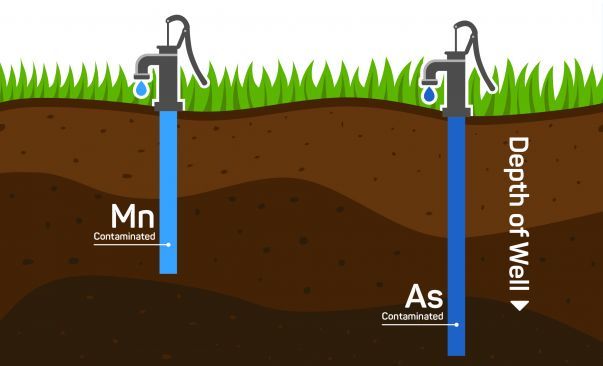Manganese in Underground Drinking Water is Cause for Concern
Published on by Water Network Research, Official research team of The Water Network in Academic
UCR study on U.S. Glacial Aquifer and 3 Asian countries suggests officials should monitor manganese as a possible public health threat.
Underground drinking water sources in parts of the U.S. and three Asian countries may not be as safe as previously thought due to high levels of manganese, especially at shallow depths, according to a study led by a researcher at the University of California, Riverside.
Manganese, a metal that is required by the body in tiny amounts, can be toxic at elevated levels, particularly in children.

UCR researchers have shown that the highest concentrations of manganese (Mn), which can be harmful to human health, are found at shallower depths than Arsenic (As) in underground drinking water wells. The study suggests that these contaminants should be evaluated separately to ensure the water is fit for consumption. Source: UCR
Samantha Ying, an assistant professor of environmental sciences in UCR’s College of Natural and Agricultural Sciences, led the study, which was published recently in Environmental Science & Technology. The paper describes manganese levels that exceed World Health Organization (WHO) guidelines in groundwater wells in Bangladesh, Cambodia, China, and the Glacial Aquifer, which spans 26 states in the northern U.S. and provides drinking water to more than 41 million Americans. Of the four regions, the Glacial Aquifer had the fewest contaminated wells.
While groundwater can be contaminated with a number of heavy metals, more emphasis has been placed on assessing the levels of arsenic than manganese, although the latter also poses a threat to human health. Levels of arsenic, a known carcinogen above the WHO’s guideline of 10 parts per billion (ppb), are enforced by the Environmental Protection Agency (EPA) in the U.S. and similar agencies in other countries. Although the WHO suggests a health-based limit of 400 ppb, manganese is not listed as a contaminant on the EPA’s National Primary Drinking Water Regulations, and therefore the levels are not monitored or enforced.
A growing number of studies have linked abnormal manganese concentrations in the brain to neurological disorders similar to Parkinson’s disease, and elevated levels in children may negatively impact neurodevelopment and cognitive performance.
In the current study, the researchers collected and analyzed chemical data from 16,000 wells in the Glacial Aquifer, the Ganges-Brahmaputra-Mehta Basin in Bangladesh, the Mekong Delta in Cambodia, and the Yangtze River Basin of China. The researchers studied the levels of arsenic and manganese at a range of depths, showing that, in general, arsenic levels increased with depth, while manganese levels decreased with depth.
When accounting for both metals at levels suggested by the WHO, the percentage of contaminated wells across all depths increased as follows:
- Glacial Aquifer (U.S): 9.3 percent contaminated when considering arsenic only; increased to 16.4 percent when considering arsenic and manganese.
- Ganges-Brahmaputra-Mehta Basin (Bangladesh): 44.5 percent contaminated when considering arsenic only; increased to 70 percent when considering arsenic and manganese.
- Mekong Delta (Cambodia): 10 percent contaminated when considering arsenic only; increased to 32 percent when considering arsenic and manganese.
- Yangtze River Basin (China): 19 percent contaminated when considering arsenic only; increased to 88 percent when considering arsenic and manganese.
Ying said omitting manganese from water monitoring protocols means public health officials are dramatically overestimating the number of safe wells in some regions. However, while arsenic contaminated wells should be avoided completely, manganese contaminated wells can be treated inexpensively or be used for agriculture rather than drinking water.
Read full article: UCR
Access study: ACS Publications
Media
Taxonomy
- Metals
- Drinking Water Security
- Drinking Water Treatment
- Groundwater
- Drinking Water Managment
- Drinking Water
- Groundwater Pollution
- Surface-Groundwater Interaction
- Groundwater Quality & Quantity
- Metals
- Groundwater Surveys and Development